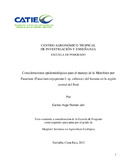| dc.contributor.author | Román Jeri, Carlos H. | |
| dc.date.accessioned | 2014-10-20T04:27:49Z | |
| dc.date.available | 2014-10-20T04:27:49Z | |
| dc.date.issued | 2012 | es_ES |
| dc.identifier | 377131 | es_ES |
| dc.identifier.uri | https://repositorio.catie.ac.cr/handle/11554/4680 | |
| dc.identifier.uri | http://orton.catie.ac.cr/repdoc/A10244e/A10244e.pdf | es_ES |
| dc.description | Tesis (M. Sc) -- CATIE, Turrialba (Costa Rica), 2012 | es_ES |
| dc.description.abstract | ii) Eliminar o reducir el inóculo primario y iii) Disminuir la tasa de infección y desarrollo de la enfermedad. Este grupo de medidas junto a los aspectos sobre análisis de riesgo de la enfermedad también discutidos en este trabajo, constituyen un importante apoyo para la toma de decisiones sobre el manejo de la MF en la zona de estudio para garantizar la Producción sostenible de banano en el Distrito de San Luís de Shuaro. Este estudio tuvo como objetivo realizar un diagnóstico de la situación actual de la Marchitez por Fusarium (MF) en el distrito de San Luís de Shuaro, provincia de Chanchamayo en la zona para generar informaciones que fundamenten estrategias de manejo integrado de la enfermedad de acuerdo a los sistemas de Producción presentes en la zona. Inicialmente 149 fincas fueron evaluadas usando diferentes parámetros para identificar los sistemas de Producción en función del arreglo espacial de los cultivos, variedad, prácticas de manejo, incidencia de plagas y enfermedades con énfasis en MF. Con base en los resultados obtenidos en el estudio se proponen un grupo de medidas de manejo integrado para el manejo de la MF que consideran estos aspectos y que fueron direccionadas a: i) Reducir la dispersión del patógeno de áreas contaminadas a áreas libres The main objective of this study was to realize a diagnose of the current situation of Fusarium wilt (MF) in the district of San Luís de Shuaro, Chanchamayo province, to generate information in support of integrated management strategies of the disease, according to production systeMON in the area. Initially 149 farMON were evaluated using different parameters to identify production systeMON, based on, the spatial distribution of the crop, variety, management practices, incidence of pests and diseases with emphasis on MF. Based on the results of this study, a set of measures for the integrated management of MF were proposed, to address these issues and were directed at: i) reducing the spread of the pathogen from contaminated areas to free areas, ii) Elimination or reduction of the primary inoculum and iii) reduction of the rate of infection and disease development. This group of measures along with certain aspects of the risk analysis of the disease (also discussed in this paper), are an important support for decision-making on the management of MF in the study area, to ensure sustainable production of bananas in the San. Luis Shuaro district. | es_ES |
| dc.language.iso | es | es_ES |
| dc.publisher | CATIE, Turrialba (Costa Rica) | es_ES |
| dc.subject | PERU | |
| dc.subject | MUSA (BANANOS) | |
| dc.subject | FUSARIUM OXYSPORUM | |
| dc.subject | SINTOMAS | |
| dc.subject | MARCHITEZ | |
| dc.subject | ENFERMEDADES DE LAS PLANTAS | |
| dc.subject | EPIDEMIOLOGIA | |
| dc.subject | CONTROL DE ENFERMEDADES DE PLANTAS | |
| dc.subject | EXPLOTACIONES AGRARIAS | |
| dc.title | Consideraciones epidemiológicas para el manejo de la marchitez por Fusarium (Fusarium oxysporum f. sp. cubense) del banano en la región central del Perú | es_ES |
| dc.type | Tesis de maestría | es_ES |
| dcterms.rights | acceso abierto | es |
| dc.identifier.publication | Turrialba (Costa Rica) | es_ES |


